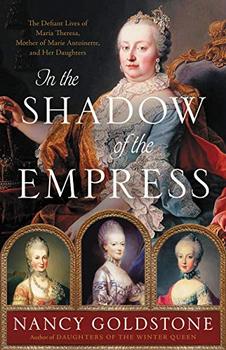Summary | Excerpt | Reading Guide | Reviews | Beyond the Book | Read-Alikes | Genres & Themes | Author Bio

The Defiant Lives of Maria Theresa, Mother of Marie Antoinette, and Her Daughters
by Nancy GoldstoneThis article relates to In the Shadow of the Empress
 By the mid-1700s, Maria Theresa, Queen of Hungary and Bohemia and Empress of the Holy Roman Empire, had suffered a significant military defeat at the hands of Prussia's King Frederick II. In the aftermath, she sought to modernize and improve her army to match that of her rival, and that included upgrading military education to focus on geography, tactics and history. This began Maria Theresa's commitment to improving education throughout her realm, which continued for another 20 years.
By the mid-1700s, Maria Theresa, Queen of Hungary and Bohemia and Empress of the Holy Roman Empire, had suffered a significant military defeat at the hands of Prussia's King Frederick II. In the aftermath, she sought to modernize and improve her army to match that of her rival, and that included upgrading military education to focus on geography, tactics and history. This began Maria Theresa's commitment to improving education throughout her realm, which continued for another 20 years.
Although she was a fervently devout Catholic, Maria Theresa understood that control of education by the Church, and particularly the Jesuit Order, had resulted in outdated curricula that was of little practical use to her subjects. She responded by changing the management of the University of Vienna and Prague University, and offering generous salaries to bring in talented faculty members from all over Europe. She also extended her reform program to public education for young children throughout Austria, issuing the General School Regulation in 1774 that "called for her subjects to be freed from the 'darkness of ignorance,'" according to Paula Sutter Fichtner in The Habsburgs: Dynasty, Culture and Politics.
This school ordinance was developed and implemented at her command by a reforming monk named Ignatius Felbiger — Maria Theresa was ultimately a conservative who didn't want to offend the Church entirely. The curriculum reinforced the idea that absolute monarchy was ordained by God and therefore the rightful order in the world, but it also contained many progressive elements.
First, the decree established elementary and secondary schools and mandated six years of attendance for both boys and girls ages six to twelve, with children from poor families exempt from school fees. Prior to this, few outside male sons of the nobility would have had an academic education — mostly via private tutors or religious schools.
The curriculum was also standardized so that children everywhere learned the same material, and teachers were trained in reading, writing and math. Training teachers seems obvious to a modern audience but in the 18th century, this was a novel program. By 1776, each capital city throughout Maria Theresa's empire had a college of education to instruct and professionalize teachers. Lastly, the government mandated that primary schoolbooks should be written in the relevant local language so that children could truly understand them, regardless of whether they had studied Latin.
As Fichtner summarizes, "Few government programs would ever serve both dynasty and its people so advantageously." Young children were taught civic and moral duties to the monarchy, but they also "learned skills that prepared them for useful and productive lives." Maria Theresa's reforms took time to develop, but at the time of her death in 1780, there were 500 schools throughout her lands. By 1800, the ratio of boys to girls was 3-to-2, representing a significant improvement in girls' education in the pre-modern period. Over a third of the young children in the kingdom were enrolled in school by the start of the 19th century, which was a success given the challenges in implementing and enforcing this policy in a geographically diverse, largely agrarian empire.
Painting of Empress Maria Theresa by Martin van Meytens, 1759
Filed under People, Eras & Events
![]() This "beyond the book article" relates to In the Shadow of the Empress. It originally ran in November 2021 and has been updated for the
September 2022 paperback edition.
Go to magazine.
This "beyond the book article" relates to In the Shadow of the Empress. It originally ran in November 2021 and has been updated for the
September 2022 paperback edition.
Go to magazine.
Your guide toexceptional books
BookBrowse seeks out and recommends the best in contemporary fiction and nonfiction—books that not only engage and entertain but also deepen our understanding of ourselves and the world around us.